2017 SUBARU FORESTER warning light
[x] Cancel search: warning lightPage 34 of 106
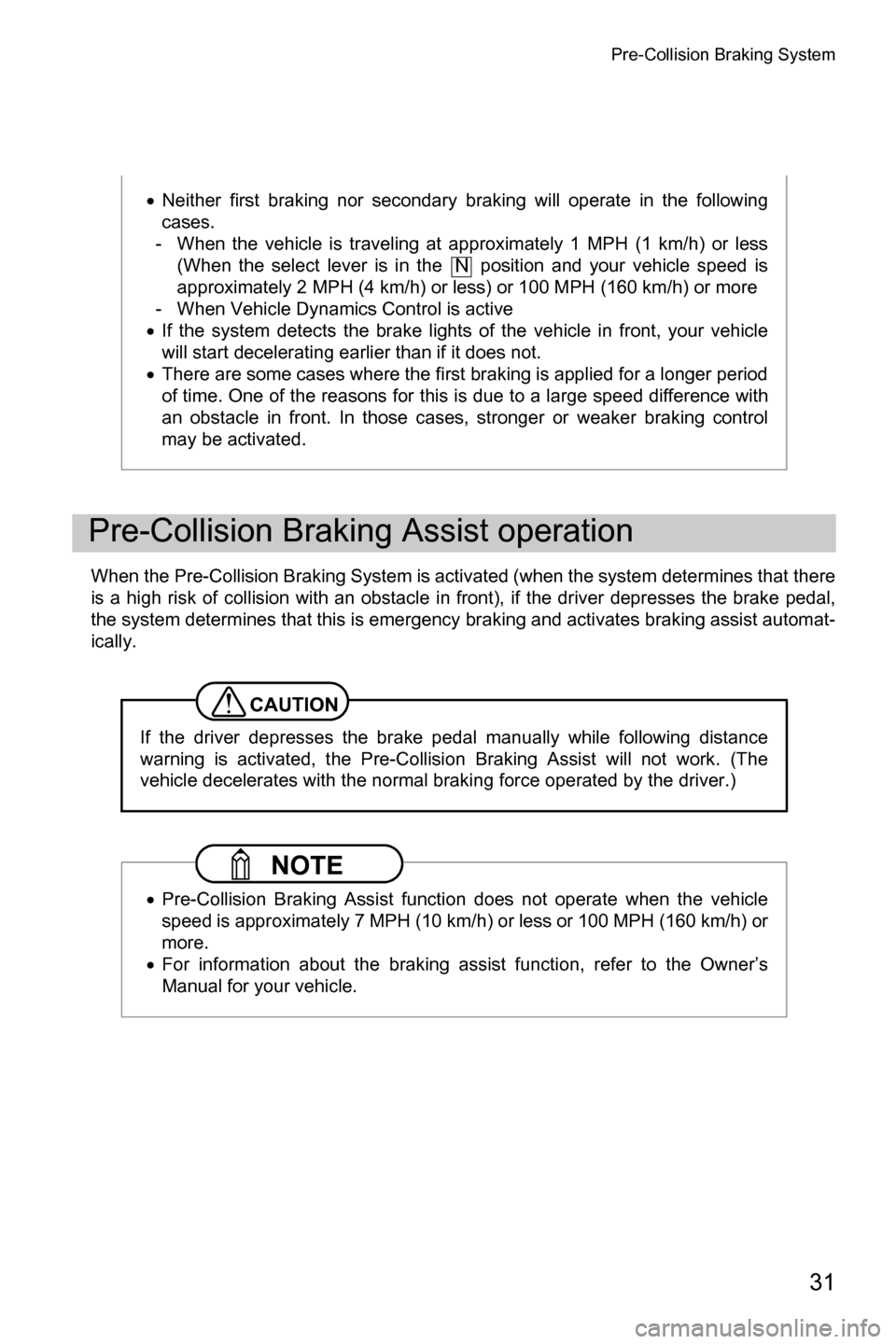
Pre-Collision Braking System
31
When the Pre-Collision Braking System is activated (when the system determines that there
is a high risk of collision with an obstacle in front), if the driver depresses the brake pedal,
the system determines that this is emergency braking and activates braking assist automat-
ically.�x
Neither first braking nor secondary braking will operate in the following
cases.
- When the vehicle is traveling at approximately 1 MPH (1 km/h) or less (When the select lever is in the position and your vehicle speed is
approximately 2 MPH (4 km/h) or less) or 100 MPH (160 km/h) or more
- When Vehicle Dynamics Control is active
�x If the system detects the brake lights of the vehicle in front, your vehicle
will start decelerating earlier than if it does not.
�x There are some cases where the first braking is applied for a longer period
of time. One of the reasons for this is due to a large speed difference with
an obstacle in front. In those cases, stronger or weaker braking control
may be activated.
Pre-Collision Braking Assist operation
CAUTION
If the driver depresses the brake pedal manually while following distance
warning is activated, the Pre-Collision Braking Assist will not work. (The
vehicle decelerates with the normal braking force operated by the driver.)
NOTE
�xPre-Collision Braking Assist function does not operate when the vehicle
speed is approximately 7 MPH (10 km/h) or less or 100 MPH (160 km/h) or
more.
�x For information about the braking assist function, refer to the Owner’s
Manual for your vehicle.
N
Page 37 of 106
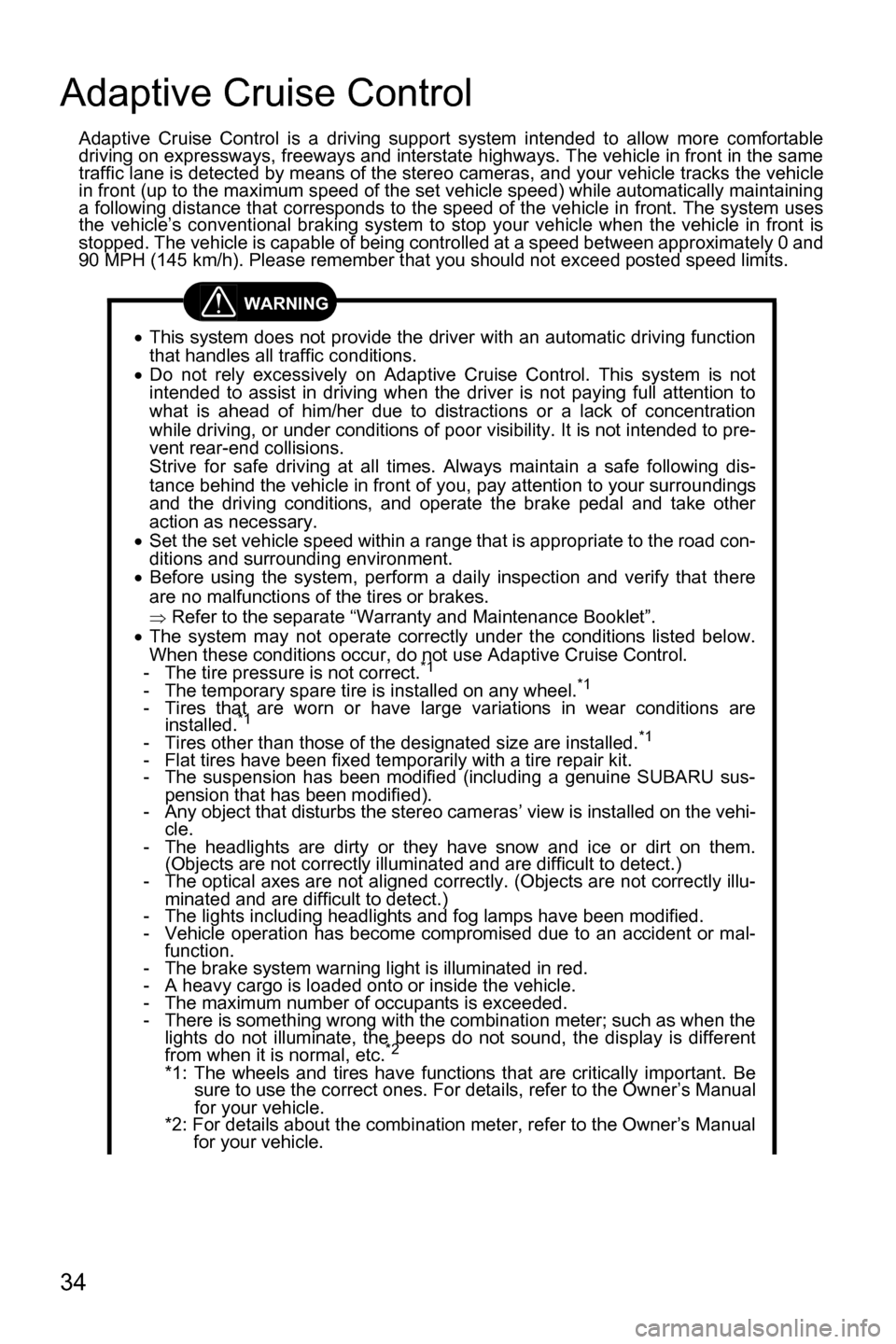
34
Adaptive Cruise Control
Adaptive Cruise Control is a driving support system intended to allow more comfortable
driving on expressways, freeways and interstate highways. The vehicle in front in the same
traffic lane is detected by means of the stereo cameras, and your vehicle tracks the vehicle
in front (up to the maximum speed of the set vehicle speed) while automatically maintaining
a following distance that corresponds to the speed of the vehicle in front. The system uses
the vehicle’s conventional braking system to stop your vehicle when the vehicle in front is
stopped. The vehicle is capable of being controlled at a speed between approximately 0 and
90 MPH (145 km/h). Please remember that you should not exceed posted speed limits.
WARNING
�x This system does not provide the driver with an automatic driving function
that handles all traffic conditions.
�x Do not rely excessively on Adaptive Cruise Control. This system is not
intended to assist in driving when the driver is not paying full attention to
what is ahead of him/her due to distractions or a lack of concentration
while driving, or under conditions of poor visibility. It is not intended to pre-
vent rear-end collisions.
Strive for safe driving at all times. Always maintain a safe following dis-
tance behind the vehicle in front of you, pay attention to your surroundings
and the driving conditions, and operate the brake pedal and take other
action as necessary.
�x Set the set vehicle speed within a range that is appropriate to the road con-
ditions and surrounding environment.
�x Before using the system, perform a daily inspection and verify that there
are no malfunctions of the tires or brakes.
�Ÿ Refer to the separate “Warranty and Maintenance Booklet”.
�x The system may not operate correctly under the conditions listed below.
When these conditions occur, do not use Adaptive Cruise Control.
- The tire pressure is not correct.
*1
- The temporary spare tire is installed on any wheel.*1
- Tires that are worn or have large variations in wear conditions are installed.*1
- Tires other than those of the designated size are installed.*1
- Flat tires have been fixed temporarily with a tire repair kit.
- The suspension has been modified (including a genuine SUBARU sus-
pension that has been modified).
- Any object that disturbs the stereo cameras’ view is installed on the vehi- cle.
- The headlights are dirty or they have snow and ice or dirt on them. (Objects are not correctly illuminated and are difficult to detect.)
- The optical axes are not aligned correctly. (Objects are not correctly illu-
minated and are difficult to detect.)
- The lights including headlights and fog lamps have been modified.
- Vehicle operation has become compromised due to an accident or mal-
function.
- The brake system warning light is illuminated in red.
- A heavy cargo is loaded onto or inside the vehicle.
- The maximum number of occupants is exceeded.
- There is something wrong with the combination meter; such as when the lights do not illuminate, the beeps do not sound, the display is different
from when it is normal, etc.
*2
*1: The wheels and tires have functions that are critically important. Be sure to use the correct ones. For details, refer to the Owner’s Manual
for your vehicle.
*2: For details about the combination meter, refer to the Owner’s Manual for your vehicle.
Page 53 of 106

Adaptive Cruise Control
50
WARNING
Do not use Adaptive Cruise Control on slippery roads. Doing so may result in
an accident.
CAUTION
When shifting the select lever to the position, Adaptive Cruise Control will
be automatically canceled. Do not shift the lever to the position unless it is
an emergency. Otherwise the engine brake may not operate, which could
cause an accident.
NOTE
�xIf EyeSight operation has temporarily stopped, the Pre-Collision Braking
System OFF indicator light and Lane Departure Warning OFF indicator
light illuminate, and the EyeSight temporary stop indicator is displayed on
the multi information display.
�Ÿ Refer to page 89.
�xIf EyeSight is malfunctioning, the EyeSight warning indicator is displayed
on the multi information display, and the Pre-Collision Braking System OFF
indicator light and Lane Departure Warning OFF indicator light will also
illuminate. If this occurs, stop the vehicle in a safe location and then turn off
the engine and restart it. If the indicators remain illuminated after restarting
the engine, Adaptive Cruise Control cannot be used. This will not interfere
with ordinary driving; however the system should be inspected by a
SUBARU dealer as soon as possible.
�Ÿ Refer to page 88.
�x When the operation of Adaptive Cruise Control has been automatically
canceled, perform the set cruise control operation again after the condition
that caused the cancellation has been corrected. If the cruise control func-
tion cannot be set even after the condition has been corrected, EyeSight
may be malfunctioning. This will not interfere with ordinary driving; how-
ever contact a SUBARU dealer and have the system inspected.
N
N
Page 55 of 106
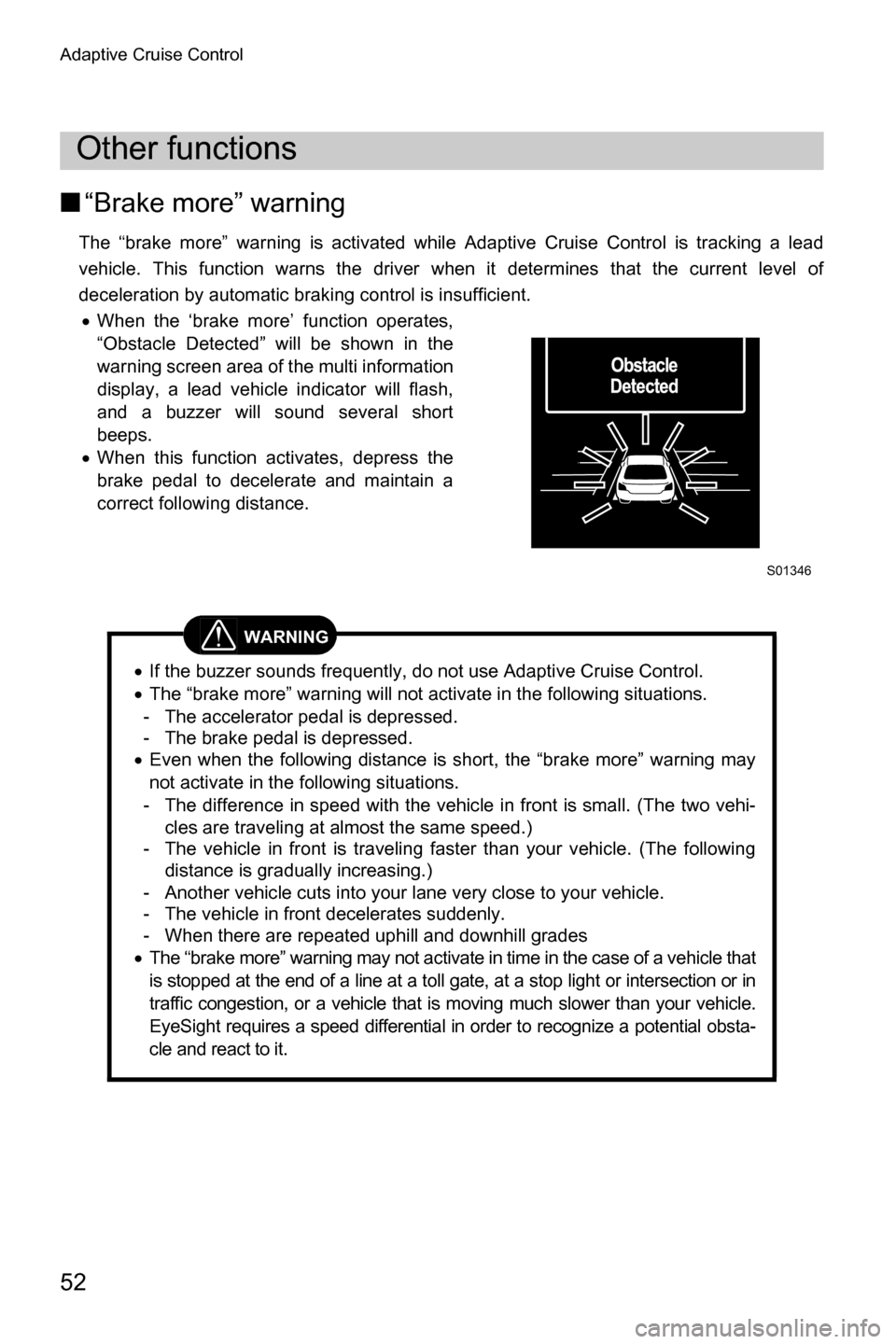
Adaptive Cruise Control
52
■“Brake more” warning
The “brake more” warning is activated while Adaptive Cruise Control is tracking a lead
vehicle. This function warns the driver when it determines that the current level of
deceleration by automatic braking control is insufficient.
�x When the ‘brake more’ function operates,
“Obstacle Detected” will be shown in the
warning screen area of the multi information
display, a lead vehicle indicator will flash,
and a buzzer will sound several short
beeps.
�x When this function activates, depress the
brake pedal to decelerate and maintain a
correct following distance.
Other functions
WARNING
�xIf the buzzer sounds frequently, do not use Adaptive Cruise Control.
�x The “brake more” warning will not activate in the following situations.
- The accelerator pedal is depressed.
- The brake pedal is depressed.
�x Even when the following distance is short, the “brake more” warning may
not activate in the following situations.
- The difference in speed with the vehicle in front is small. (The two vehi- cles are traveling at almost the same speed.)
- The vehicle in front is traveling faster than your vehicle. (The following
distance is gradually increasing.)
- Another vehicle cuts into your lane very close to your vehicle.
- The vehicle in front decelerates suddenly.
- When there are repeated uphill and downhill grades
�x The “brake more” warning may not activate in time in the case of a vehicle that
is stopped at the end of a line at a toll gate, at a stop light or intersection or in
traffic congestion, or a vehicle that is moving much slower than your vehicle.
EyeSight requires a speed differential in order to recognize a potential obsta-
cle and react to it.
S01346
Page 58 of 106
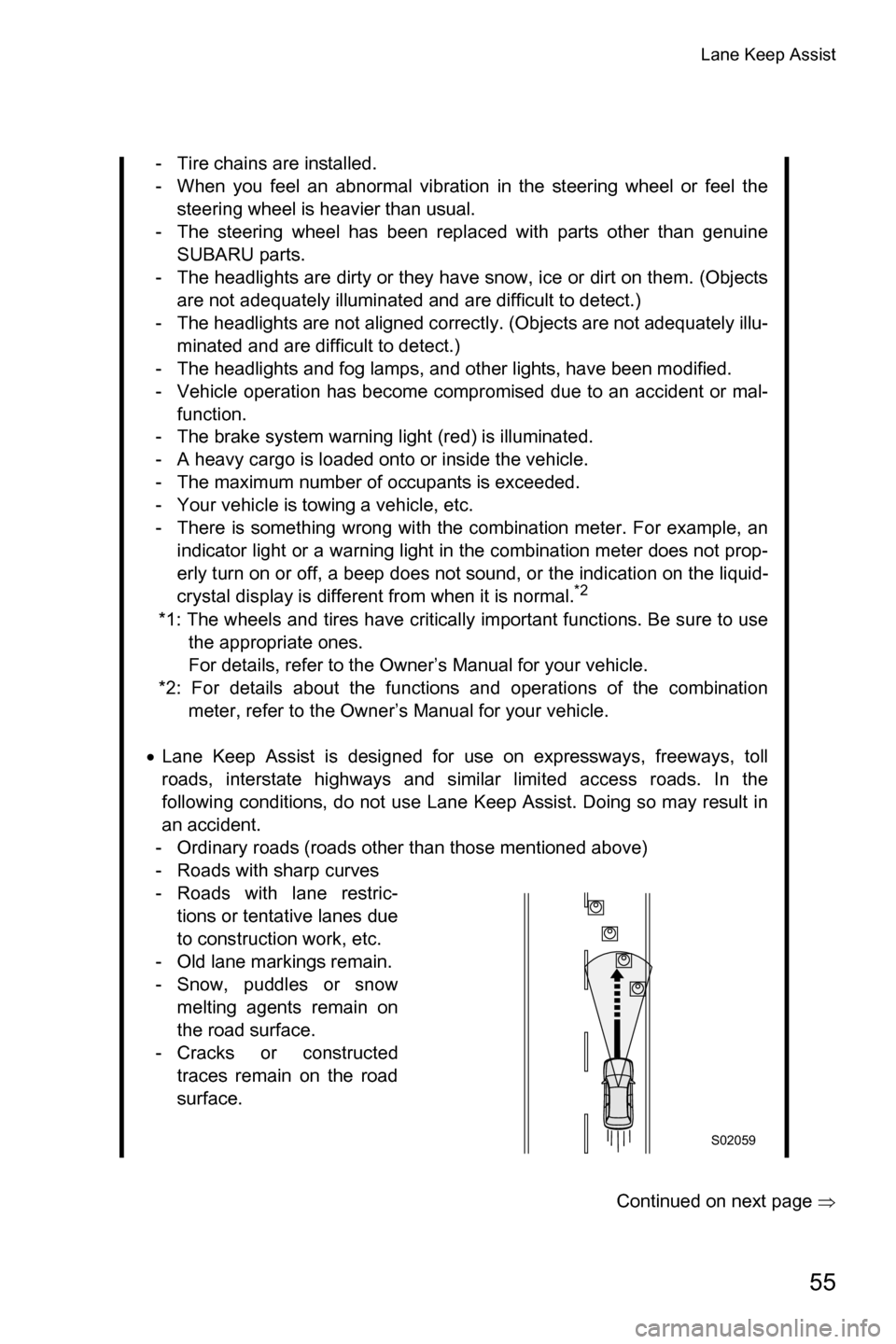
Lane Keep Assist
55
Continued on next page �Ÿ
- Tire chains are installed.
- When you feel an abnormal vibration in the steering wheel or feel the
steering wheel is heavier than usual.
- The steering wheel has been replaced with parts other than genuine SUBARU parts.
- The headlights are dirty or they have snow, ice or dirt on them. (Objects are not adequately illuminated and are difficult to detect.)
- The headlights are not aligned correctly. (Objects are not adequately illu- minated and are difficult to detect.)
- The headlights and fog lamps, and other lights, have been modified.
- Vehicle operation has become compromised due to an accident or mal- function.
- The brake system warning light (red) is illuminated.
- A heavy cargo is loaded onto or inside the vehicle.
- The maximum number of occupants is exceeded.
- Your vehicle is towing a vehicle, etc.
- There is something wrong with the combination meter. For example, an indicator light or a warning light in the combination meter does not prop-
erly turn on or off, a beep does not sound, or the indication on the liquid-
crystal display is different from when it is normal.
*2
*1: The wheels and tires have critically important functions. Be sure to use
the appropriate ones.
For details, refer to the Owner’s Manual for your vehicle.
*2: For details about the functions and operations of the combination meter, refer to the Owner’s Manual for your vehicle.
�x Lane Keep Assist is designed for use on expressways, freeways, toll
roads, interstate highways and similar limited access roads. In the
following conditions, do not use Lane Keep Assist. Doing so may result in
an accident.
- Ordinary roads (roads other than those mentioned above)
- Roads with sharp curves
- Roads with lane restric- tions or tentative lanes due
to construction work, etc.
- Old lane markings remain.
- Snow, puddles or snow melting agents remain on
the road surface.
- Cracks or constructed traces remain on the road
surface.
S02059
Page 62 of 106
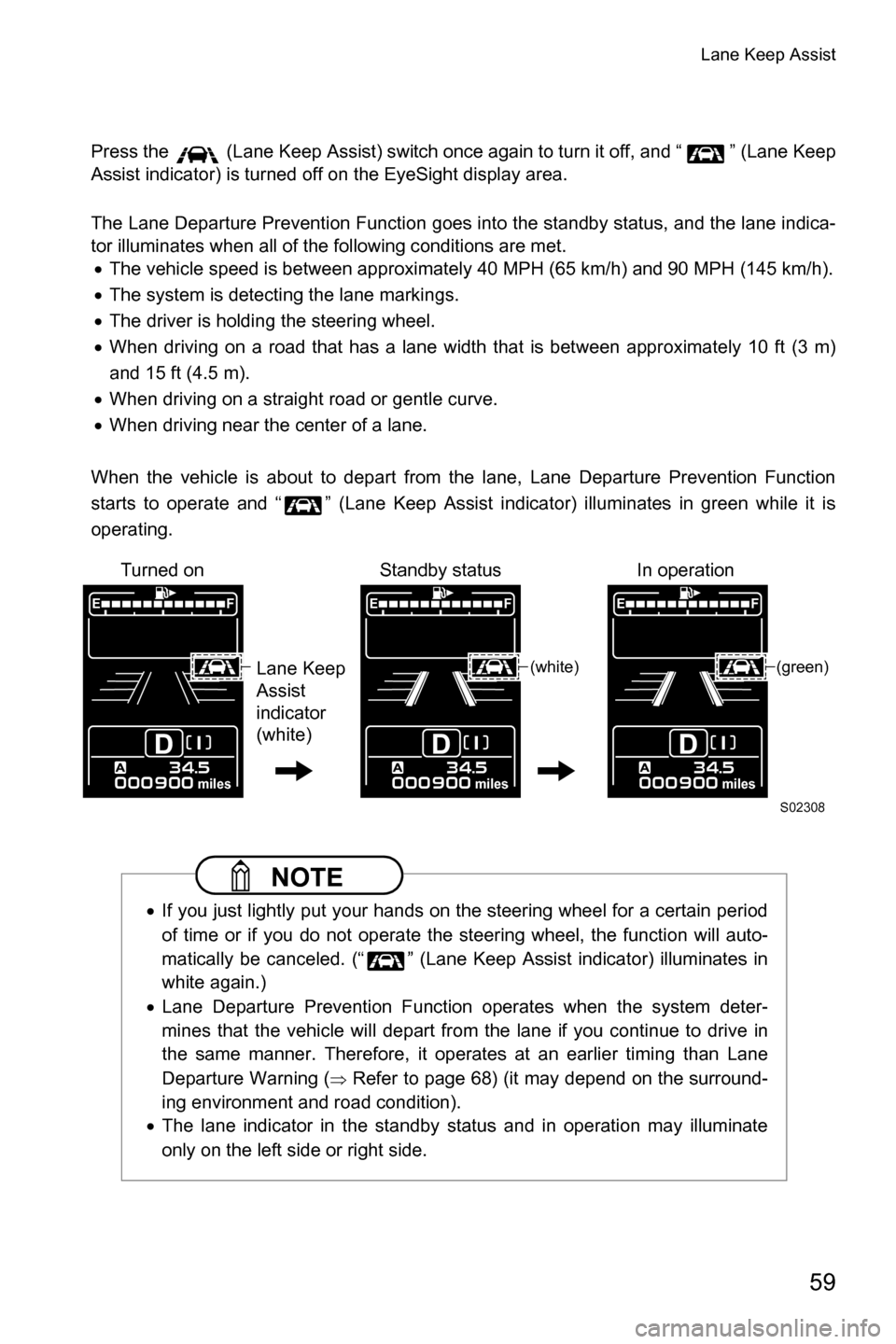
Lane Keep Assist
59
Press the (Lane Keep Assist) switch once again to turn it off, and “ ” (Lane Keep
Assist indicator) is turned off on the EyeSight display area.
The Lane Departure Prevention Function goes into the standby status, and the lane indica-
tor illuminates when all of the following conditions are met.�x The vehicle speed is between approximately 40 MPH (65 km/h) and 90 MPH (145 km/h).
�x The system is detecting the lane markings.
�x The driver is holding the steering wheel.
�x When driving on a road that has a lane width that is between approximately 10 ft (3 m)
and 15 ft (4.5 m).
�x When driving on a straight road or gentle curve.
�x When driving near the center of a lane.
When the vehicle is about to depart from the lane, Lane Departure Prevention Function
starts to operate and “ ” (Lane Keep Assist indicator) illuminates in green while it is
operating.
NOTE
�x If you just lightly put your hands on the steering wheel for a certain period
of time or if you do not operate the steering wheel, the function will auto-
matically be canceled. (“ ” (Lane Keep Assist indicator) illuminates in
white again.)
�x Lane Departure Prevention Function operates when the system deter-
mines that the vehicle will depart from the lane if you continue to drive in
the same manner. Therefore, it operates at an earlier timing than Lane
Departure Warning (
�Ÿ Refer to page 68) (it may depend on the surround-
ing environment and road condition).
�x The lane indicator in the standby status and in operation may illuminate
only on the left side or right side.
milesmilesmiles
E
FEFEF
S02308
Lane Keep
Assist
indicator
(white)
Turned on Standby status In operation(white)
(green)
Page 63 of 106
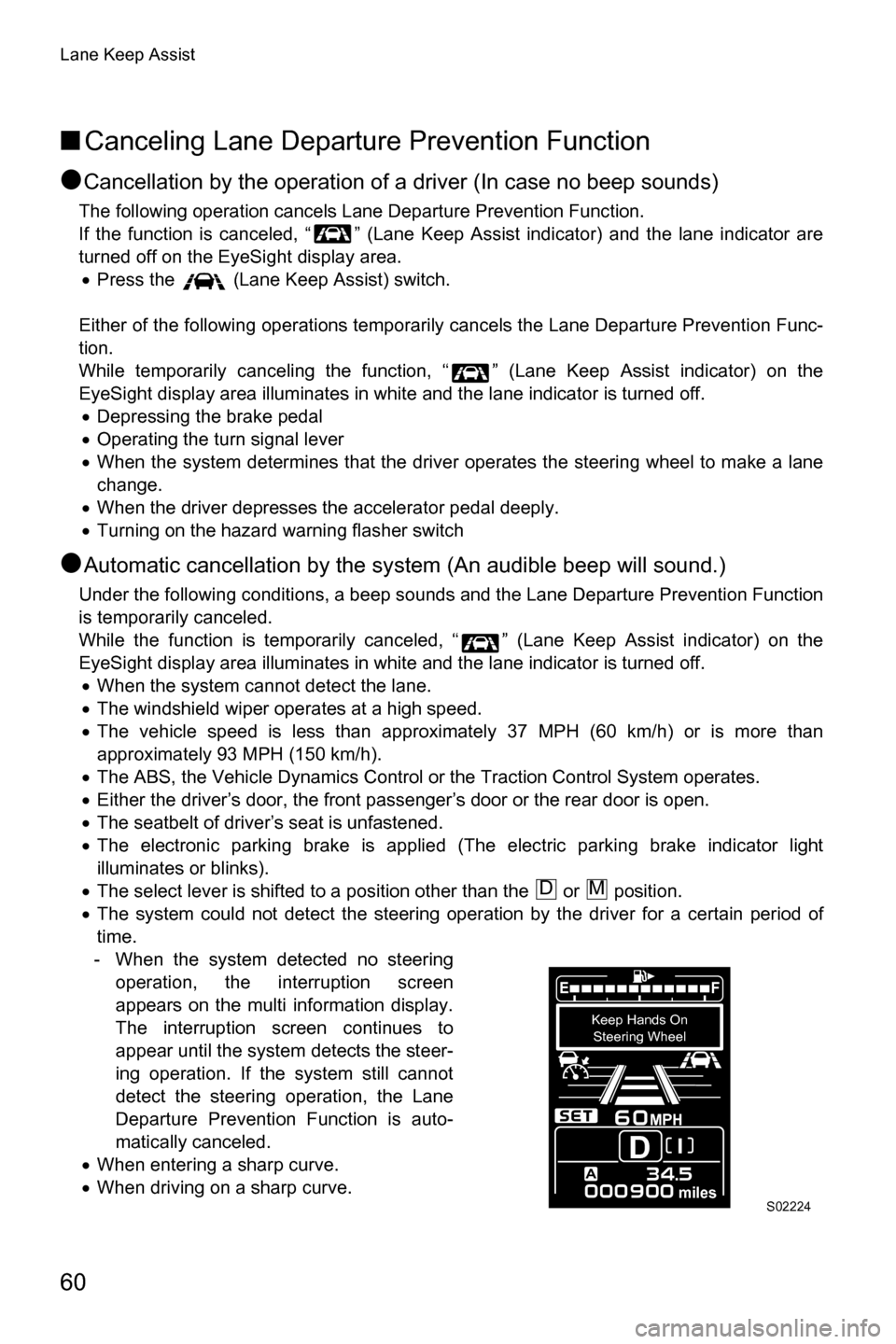
Lane Keep Assist
60
■Canceling Lane Departure Prevention Function
●
Cancellation by the operation of a driver (In case no beep sounds)
The following operation cancels Lane Departure Prevention Function.
If the function is canceled, “ ” (Lane Keep Assist indicator) and the lane indicator are
turned off on the EyeSight display area. �x Press the (Lane Keep Assist) switch.
Either of the following operations temporarily cancels the Lane Departure Prevention Func-
tion.
While temporarily canceling the function, “ ” (Lane Keep Assist indicator) on the
EyeSight display area illuminates in white and the lane indicator is turned off. �x Depressing the brake pedal
�x Operating the turn signal lever
�x When the system determines that the driver operates the steering wheel to make a lane
change.
�x When the driver depresses the accelerator pedal deeply.
�x Turning on the hazard warning flasher switch
●Automatic cancellation by the system (An audible beep will sound.)
Under the following conditions, a beep sounds and the Lane Departure Prevention Function
is temporarily canceled.
While the function is temporarily canceled, “ ” (Lane Keep Assist indicator) on the
EyeSight display area illuminates in white and the lane indicator is turned off.
�x When the system cannot detect the lane.
�x The windshield wiper operates at a high speed.
�x The vehicle speed is less than approximately 37 MPH (60 km/h) or is more than
approximately 93 MPH (150 km/h).
�x The ABS, the Vehicle Dynamics Control or the Traction Control System operates.
�x Either the driver’s door, the front passenger’s door or the rear door is open.
�x The seatbelt of driver’s seat is unfastened.
�x The electronic parking brake is applied (The electric parking brake indicator light
illuminates or blinks).
�x The select lever is shifted to a position other than the or position.
�x The system could not detect the steering operation by the driver for a certain period of
time.
- When the system detected no steering operation, the interruption screen
appears on the multi information display.
The interruption screen continues to
appear until the system detects the steer-
ing operation. If the system still cannot
detect the steering operation, the Lane
Departure Prevention Function is auto-
matically canceled.
�x When entering a sharp curve.
�x When driving on a sharp curve.
DM
AD
miles
MPH
Keep Hands On
Steering Wheel
E F
S02224
Page 72 of 106
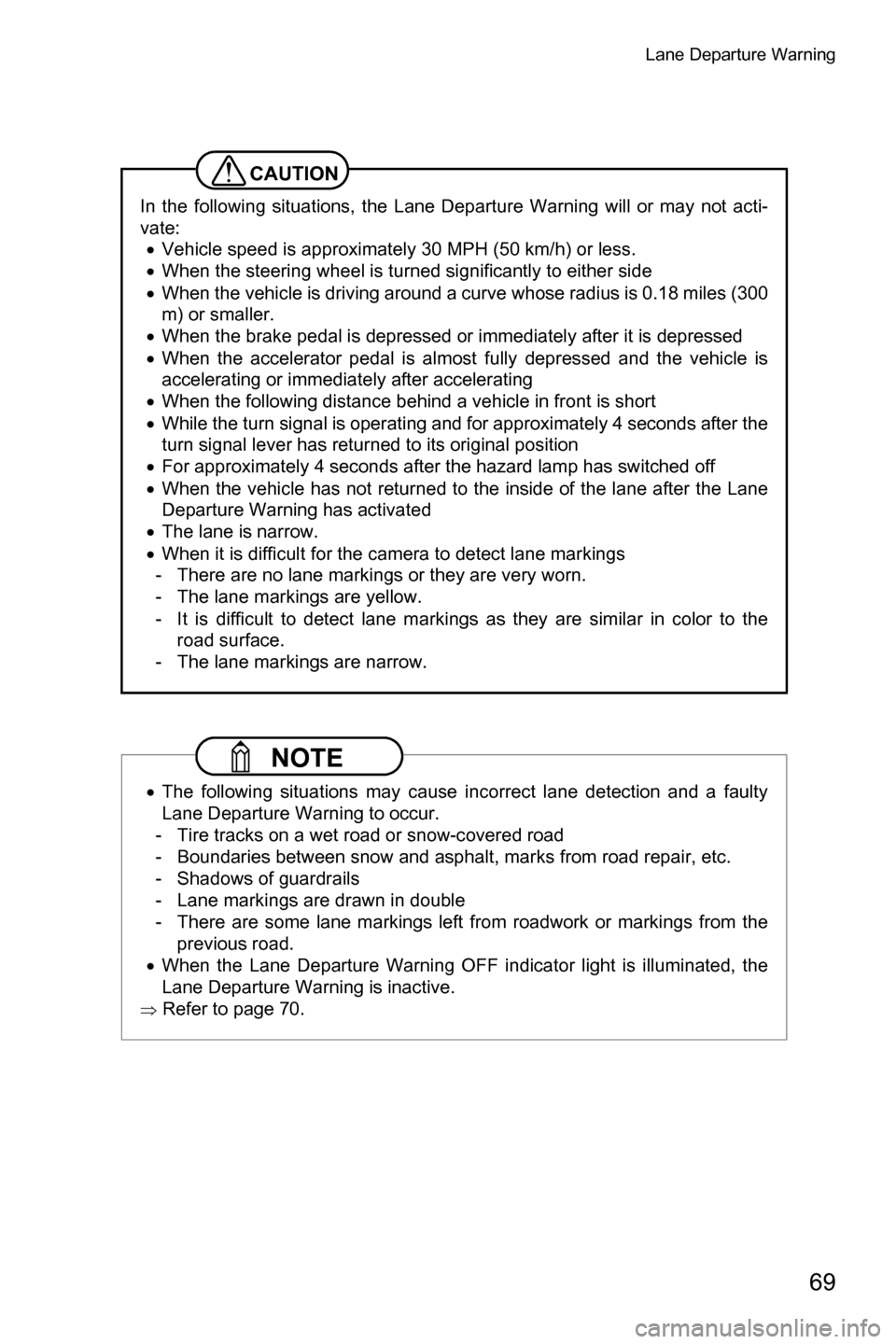
Lane Departure Warning
69
CAUTION
In the following situations, the Lane Departure Warning will or may not acti-
vate:�x Vehicle speed is approximately 30 MPH (50 km/h) or less.
�x When the steering wheel is turned significantly to either side
�x When the vehicle is driving around a curve whose radius is 0.18 miles (300
m) or smaller.
�x When the brake pedal is depressed or immediately after it is depressed
�x When the accelerator pedal is almost fully depressed and the vehicle is
accelerating or immediately after accelerating
�x When the following distance behind a vehicle in front is short
�x While the turn signal is operating and for approximately 4 seconds after the
turn signal lever has returned to its original position
�x For approximately 4 seconds after the hazard lamp has switched off
�x When the vehicle has not returned to the inside of the lane after the Lane
Departure Warning has activated
�x The lane is narrow.
�x When it is difficult for the camera to detect lane markings
- There are no lane markin gs or they are very worn.
- The lane markings are yellow.
- It is difficult to detect lane markings as they are similar in color to the road surface.
- The lane markings are narrow.
NOTE
�x The following situations may cause incorrect lane detection and a faulty
Lane Departure Warning to occur.
- Tire tracks on a wet road or snow-covered road
- Boundaries between snow and asphalt, marks from road repair, etc.
- Shadows of guardrails
- Lane markings are drawn in double
- There are some lane markings left from roadwork or markings from the previous road.
�x When the Lane Departure Warning OFF indicator light is illuminated, the
Lane Departure Warning is inactive.
�Ÿ Refer to page 70.